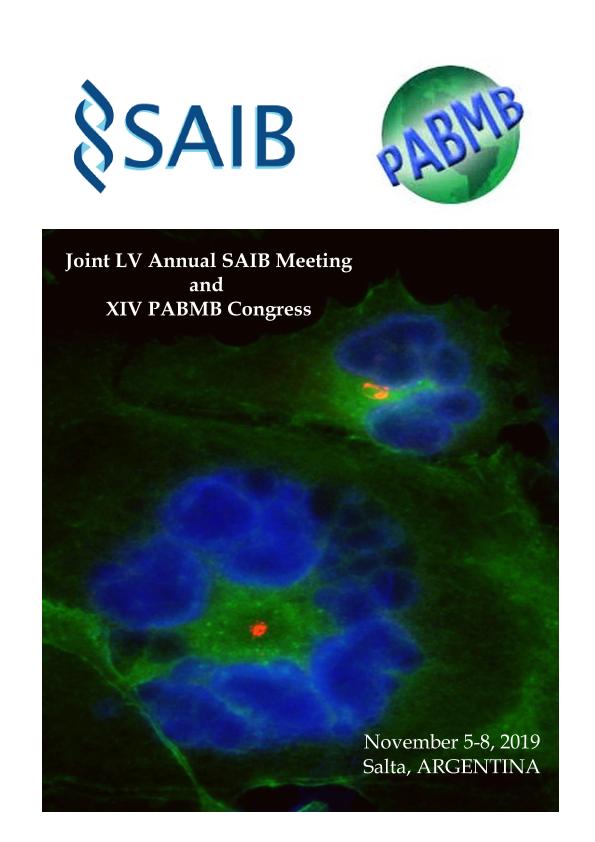Mostrar el registro sencillo del ítem
dc.contributor.author
Giaccio, Graciela Marta

dc.contributor.author
Aparicio, Virginia Carolina

dc.contributor.author
Estévez, Maria Cristina

dc.contributor.author
de Gerónimo, Eduardo

dc.contributor.author
Corral, Raúl Alejandro

dc.contributor.author
Dávila Costa, José Sebastián

dc.contributor.author
Alvarez, Analia

dc.date.available
2022-12-13T17:10:57Z
dc.date.issued
2019
dc.identifier.citation
Glyphosate removal by riparian vegetable species and isolation of associated bacteria; The LV Annual SAIB Meeting and XIV PABMB Congress; Salta; Argentina; 2019; 147
dc.identifier.issn
0327-9545
dc.identifier.uri
http://hdl.handle.net/11336/181022
dc.description.abstract
Glyphosate (Gly) is the most used herbicide in Argentina. Consequently, a higher occurrence of Gly and its major metabolite (AMPA) in differentenvironmental compartments are currently found. Plants growing in such environments can reduce pollutant loads. Contaminated soils andvegetation represent a source of potentially beneficial plant associated-bacteria that could be used within microbial-assisted remediation strategies.The objectives of this study were (1) to isolate bacterial strains from Gly contaminated soil and rhizosphere of Salix fragilis (Sf) and Festucaarundinacea (Fa) spontaneously grown on soils contaminated, and (2) to evaluate Gly and AMPA content in soil and plant tissue of Sf and Fagrown in a greenhouse experiment. Samples of top soils contaminated with Gly and samples of Sf and Fa growing in the surroundings of theClaromecó stream (Tres Arroyos) were collected. For the bacterial isolation, one g of bulk soil (S) and rhizosphere soil (R) was suspended in asterile solution. Soil suspensions were diluted and plated. After 7 days of incubation, distinct colony morphotypes isolated were screened accordingto use Gly (0.5 g L-1) as only carbon source (minimal medium+Gly) and to use Gly as only P source (mineral salt medium+sodium glutamate+Gly). For the greenhouse experiment, pots were filled with 2 kg of contaminated soil and one Sf cutting and 6 Fa seedlings were planted per pot, for 3months. Four pot replicates were prepared for each treatment, including control pots. At the end of the experiment, plants were harvested, and soilsamples were taken for Gly and AMPA analysis by UPLC-MS/MS. Sixty-nine different colonies morphotypes, 23 from S and 46 from R (26 fromFa and 20 from Sf) were isolated. Seventeen of the isolates were able to grow on Gly as source of P and 14 were able to grow using Gly as sourceof C. Five of different bacterial morphotypes were able to grow using Gly as source of P and C. In the greenhouse experiment, Gly and AMPAinitial content in soils were 5512 ± 1369 μg kg-1 and 2353 ± 181 μg kg-1, (respectively). At the end of the assay, Gly final content was 325 ± 23μg kg-1 (Sf) and 25 ± 2 μg kg-1 (Fa) showing both a noticeable decrease in planted soils. AMPA final content was also decreased in Fa (822 ± 104μg kg-1) while for Sf AMPA was enhanced (3853 ± 207 μg kg-1). Gly detected in plant biomass was 513 ± 97 μg kg-1 (Sf) and 164 ± 50 μg kg-1(Fa). AMPA content in plants was 2385 ± 726 μg kg-1 (Sf) and 575 ± 87 μg kg-1 (Fa). In control pots, differences in contaminant content were notsignificant during the assay. Since Fa treatment showed decreased values of Gly and AMPA both in plant and soil, and five of different bacterialmorphotypes were able to grow using Gly as a source of P and C, bioassays combining both bacterial inoculant and Fa are currently in course.The microbial-plant system could be considered a promising tool for the phytoremediation of Gly and AMPA.
dc.format
application/pdf
dc.language.iso
eng
dc.publisher
Tech Science Press

dc.rights
info:eu-repo/semantics/openAccess
dc.rights.uri
https://creativecommons.org/licenses/by-nc-sa/2.5/ar/
dc.subject
GLYPHOSATE
dc.subject
BIOREMEDIATION
dc.subject
VEGETABLE SPECIES
dc.subject.classification
Bioremediación, Diagnóstico Biotecnológico en Gestión Medioambiental

dc.subject.classification
Biotecnología del Medio Ambiente

dc.subject.classification
INGENIERÍAS Y TECNOLOGÍAS

dc.title
Glyphosate removal by riparian vegetable species and isolation of associated bacteria
dc.type
info:eu-repo/semantics/publishedVersion
dc.type
info:eu-repo/semantics/conferenceObject
dc.type
info:ar-repo/semantics/documento de conferencia
dc.date.updated
2022-12-01T10:42:20Z
dc.journal.pagination
147
dc.journal.pais
Estados Unidos

dc.journal.ciudad
Nevada
dc.description.fil
Fil: Giaccio, Graciela Marta. Instituto Nacional de Tecnología Agropecuaria. Centro Regional Buenos Aires Sur. Estación Experimental Agropecuaria Barrow; Argentina
dc.description.fil
Fil: Aparicio, Virginia Carolina. Instituto Nacional de Tecnología Agropecuaria; Argentina. Consejo Nacional de Investigaciones Científicas y Técnicas. Centro Científico Tecnológico Conicet - Mar del Plata. Instituto de Innovación para la Producción Agropecuaria y el Desarrollo Sostenible - Instituto Nacional de Tecnología Agropecuaria. Centro Regional Buenos Aires Sur. Estación Experimental Agropecuaria Balcarce. Instituto de Innovación para la Producción Agropecuaria y el Desarrollo Sostenible; Argentina
dc.description.fil
Fil: Estévez, Maria Cristina. Universidad Nacional de Tucumán; Argentina. Consejo Nacional de Investigaciones Científicas y Técnicas. Centro Científico Tecnológico Conicet - Tucumán. Planta Piloto de Procesos Industriales Microbiológicos; Argentina
dc.description.fil
Fil: de Gerónimo, Eduardo. Instituto Nacional de Tecnología Agropecuaria. Centro Regional Buenos Aires Sur. Estación Experimental Agropecuaria Balcarce. Agencia de Extensión Rural Balcarce; Argentina. Consejo Nacional de Investigaciones Científicas y Técnicas; Argentina
dc.description.fil
Fil: Corral, Raúl Alejandro. Instituto Nacional de Tecnología Agropecuaria. Centro Regional Buenos Aires Sur. Estación Experimental Agropecuaria Barrow; Argentina. Consejo Nacional de Investigaciones Científicas y Técnicas; Argentina
dc.description.fil
Fil: Dávila Costa, José Sebastián. Consejo Nacional de Investigaciones Científicas y Técnicas. Centro Científico Tecnológico Conicet - Tucumán. Planta Piloto de Procesos Industriales Microbiológicos; Argentina
dc.description.fil
Fil: Alvarez, Analia. Consejo Nacional de Investigaciones Científicas y Técnicas. Centro Científico Tecnológico Conicet - Tucumán. Planta Piloto de Procesos Industriales Microbiológicos; Argentina
dc.relation.alternativeid
info:eu-repo/semantics/altIdentifier/url/https://techscience.com/biocell/v39nSuppl.S/34055/pdf
dc.conicet.rol
Autor

dc.conicet.rol
Autor

dc.conicet.rol
Autor

dc.conicet.rol
Autor

dc.conicet.rol
Autor

dc.conicet.rol
Autor

dc.conicet.rol
Autor

dc.coverage
Internacional
dc.type.subtype
Reunión
dc.description.nombreEvento
The LV Annual SAIB Meeting and XIV PABMB Congress
dc.date.evento
2019-11-05
dc.description.ciudadEvento
Salta
dc.description.paisEvento
Argentina

dc.type.publicacion
Journal
dc.description.institucionOrganizadora
Sociedad Argentina de Investigación en Bioquímica y Biología Molecular
dc.source.revista
Biocell

dc.date.eventoHasta
2019-11-08
dc.type
Reunión
Archivos asociados
